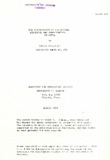| dc.description.abstract | This paper describes some preliminary data on the disparities in
education provision in Kenya. Comparisons are made between educational
opportunities in rural and urban areas and among different rural communities.
The financial burdens of education are also shown to be distributed
unevenly among different social groups. The origins of inequalities in
education provision are traced to the colonial period, and the disparities
in the provision of primary and secondary school places, which have persisted
and in some cases increased since independence) are pointed out. In addition the quality of the education provided by different primary
schools and by the three different types of secondary schools, as measured in
t arms of equipment; provided, teachers I academic qualifications and school
leavers! examination scores, is compared, and the prejudice against Harambee
school leavers in the labour market is discussed It clearly emerges from this analysis that educational benefits are.
being distributed in favour of the economically and politically powerful
districts and provinces in the country. The existing stratification of school
at primary and secondary levels perpetuates the income inequalities in the
society. | en |

